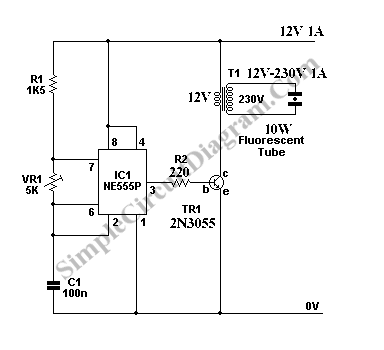12V Neon Lamp Circuit
Neon lamp or tube lamp need high voltage to trigger the ionization of the gas inside the tube. After the ionization occurs, the voltage drops around 40 volts to maintain the current. To drive a neon lamp (fluorescent lamp) using 12 volts battery, we need to convert the DC voltage to high AC voltage. High voltage is needed to trigger the ionization process (220v) and to maintain the ionized state of the gas (40V). Tube lamp (TL) can work with DC voltage, but the tube will ages faster since the DC current will make the tube to burn faster on one side and slower on the opposite side, since gas ionization makes one direction mass transfer. Using AC voltage, the ion flow in the tube is bidirectional and it makes the tube life last longer. Here is the schematic diagram of the circuit:

The transistor should be installed with proper heatsink. You can use a standard step-down transformer, but here we use it as a step-up transformer simply by driving the secondary winding (12V) to produce higher voltage on primary winding (230V). The circuit doesn’t need to heat the tube’s filament, so you can even use a tube lamp with broken filamet. The voltage output of this transformer is high enough to trigger the ionization without heating. Finally, the circuit is designed for 10W tube lamp, if you want it to work on different wattage, you can change the transformer T1, the transisor TR1, and the resistor R2.